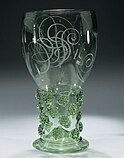Talk:Engraved glass
A fact from Engraved glass appeared on Wikipedia's Main Page in the Did you know column on 11 June 2021 (check views). The text of the entry was as follows:
|  |
| This article is rated B-class on Wikipedia's content assessment scale. It is of interest to the following WikiProjects: | ||||||||||||||||||
| ||||||||||||||||||
A Brief History of Glass Engraving[edit]
Glass originated in the Bronze Age 5,000 and 4,000BC, the first objects being opaque beads. The techniques of cutting and wheel engraving already used on jewellery were perfected in lower Egypt and exported to Italy, Greece and elsewhere. With extensive trade connections developing between the near East and Italy in the 12th and 13th Cs, the craft moved into Europe. In the second half of the 15th and 16th Cs came the Renaissance and new experiments in glassmaking. Wheel engraving is done with mostly copper rotating wheels, the spindle fixed to the shaft of the machine. The wheels are of different sizes and shapes, changing according to need and smeared with emery powder and oil. Engraving with a diamond point was introduced into Venetian glassmaking. The fashion at the time was for clear glass which was ideal for this method. There was also glass being made in Scandenavia, Holland, France and Belgium around this time and a London glassworks was founded in 1571. In the 17C, Bohemian glass merchants became a very strong factor in the European glass trade and beat their competitors in the quality of the new crystal glass and new techniques in cutting and engraving. The natural colour of glass is greenish or brownish and clear glass can only be obtained by cleaning the raw materials and decolourising using chemicals. Whenlead oxide is used as a fluxing agent, lead crystal is formed - the most suitable glass for complicated cutting. Caspar Lehmann, who came to Prague from Germany in 1588 to engrave glass for Rudolf 11, was honoured as the first glass engraver of modern times. His work is displayed in museums in Vienna, Prague and London. Glass engraving spread rapidly during the end of the 17C as glass decorators' guilds were established and the quality of engraved decorations improved sharply. A variety of subjects were used including portraits, mythology, animals, townscapes and landscapes. They were usually highly ornamented. In Holland, a new technique, stippling, developed by Frans Greenwood. This new method, with its uneven density and light dots, became popular. The traditional techniques remained in the forefront in Bohemia, and the most famous engraver of the first half of the 19C is Dominik Biemann, who left a large range of signed works. From the 1840's, glass engraving ceased to pay...it was too expensive a technique for owners of glass works and many engravers had to take up other crafts. Engraved glass was a popular product throughout the 19C and shading and line associated with engraving were ideally suited to the new thin blowing style of glassware. At the London International Exhibition of 1862, the Bohemian craftsmen who exhibited showed the extraordinary skills and excellence of their work. However, at the end of the 1870's, the art of the Far East was discovered and this had an especially strong impact on the style of glassware produced. Then came Art Nouveau and Art Deco where pressed or mould blown glass having sculptured designs incorporated were produced. Mass production took over. There are glass engravers in many countries around the world. In Australia, Faye Thomson has been engraving glass for more than 30 years. — Preceding unsigned comment added by Craftartistry (talk • contribs) 01:21, 15 February 2013 (UTC)
Did you know nomination[edit]
- The following is an archived discussion of the DYK nomination of the article below. Please do not modify this page. Subsequent comments should be made on the appropriate discussion page (such as this nomination's talk page, the article's talk page or Wikipedia talk:Did you know), unless there is consensus to re-open the discussion at this page. No further edits should be made to this page.
The result was: promoted by Desertarun (talk) 15:18, 5 June 2021 (UTC)

- ... that some of the most celebrated Dutch Golden Age artists in glass engraving were women? Source: Battie, David and Cottle, Simon, eds., Sotheby's Concise Encyclopedia of Glass, 1991, Conran Octopus, ISBN 1850296545, p. 90
5x expanded by Johnbod (talk). Self-nominated at 03:40, 20 May 2021 (UTC).
- [[:File:Engraved rummer - Sic Soleo Amicos - attributed to Maria Tesselschade Roemers Visscher - Rijksmuseum - BK-NM-10754-50.jpg|thumb|Rummer, engraving attributed to Maria Tesselschade Visscher]] - what's the problem with filename here?? Johnbod (talk) 03:44, 20 May 2021 (UTC)
 @Johnbod: This article is a fivefold expansion and is new enough and long enough. The image is suitably licensed, the hook facts are cited inline, the article is neutral, and I detected no copyright issues. Just waiting for the QPQ. Cwmhiraeth (talk) 18:25, 22 May 2021 (UTC)
@Johnbod: This article is a fivefold expansion and is new enough and long enough. The image is suitably licensed, the hook facts are cited inline, the article is neutral, and I detected no copyright issues. Just waiting for the QPQ. Cwmhiraeth (talk) 18:25, 22 May 2021 (UTC)
- QPQ done (Template:Did you know nominations/National Museum of Ireland – Decorative Arts and History). Johnbod (talk) 14:44, 30 May 2021 (UTC)
 Thank you. This nomination is good to go. Cwmhiraeth (talk) 18:05, 30 May 2021 (UTC)
Thank you. This nomination is good to go. Cwmhiraeth (talk) 18:05, 30 May 2021 (UTC)

